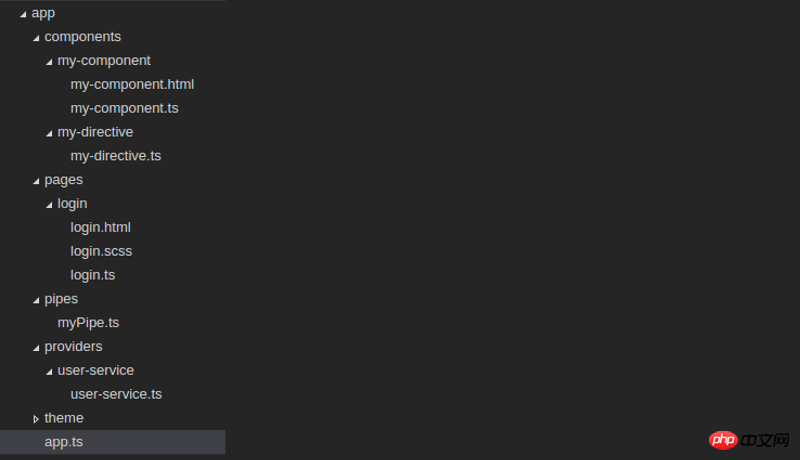Rumah >hujung hadapan web >tutorial js >在ionic2中怎样使用自动生成器
在ionic2中怎样使用自动生成器
- php中世界最好的语言asal
- 2018-03-17 11:44:051731semak imbas
这次给大家带来在ionic2中怎样使用自动生成器,在ionic2中使用自动生成器的注意事项有哪些,下面就是实战案例,一起来看一下。
ionic generator是命令行的功能,ionic2自动帮我们创建应用程序,从而节省了大量的时间,并增加我们的速度来开发一个项目的关键部分。
ionic generator使我们可以自动创建以下几部份:
•component
•directive
•page
•provider
一、创建页面:ionic g page [PageName]
通过这个命令创建一个新的页面,ionic2项目中这个命令使用最多
我们只需要进入我们的命令行中,并运行下面的命令:
ionic g page login # Results: √ Create app/pages/login/login.html √ Create app/pages/login/login.scss √ Create app/pages/login/login.ts
login.ts:
import {Component} from '@angular/core';
import {NavController} from 'ionic-angular';
@Component({
templateUrl: 'build/pages/login/login.html',
})
export class LoginPage {
constructor(public nav: NavController) {}
}
login.html:
<ion-header> <ion-navbar> <ion-title> login </ion-title> </ion-navbar> </ion-header> <ion-content padding class="login"> </ion-content>
二、创建组件:ionic g component [ComponentName]
组件是一段代码,可以在我们的应用程序的任何部分使用
通过这个命令创建一个组件:
ionic g component myComponent # Results: √ Create app/components/my-component/my-component.html √ Create app/components/my-component/my-component.ts
my-component.ts:
import {Component} from '@angular/core';
@Component({
selector: 'my-component',
templateUrl: 'build/components/my-component/my-component.html'
})
export class MyComponent {
text: string = "";
constructor() {
this.text = 'Hello World';
}
}
三、创建指令:ionic g directive [DirectiveName]
指令,我们的应用程序可以在任何元素上使用的修饰符属性.
ionic g directive myDirective # Results: √ Create app/components/my-directive/my-directive.ts
my-directive.ts:
import {Directive} from '@angular/core';
@Directive({
selector: '[my-directive]' // Attribute selector
})
export class MyDirective {
constructor() {
console.log('Hello World');
}
}
四、创建服务提供者:ionic g provider [ProviderName]
现在创建一个新的服务(提供者),提供者负责处理数据的REST API的连接,本地存储,SQLite的等等。
要创建它,我们去运行以下命令我们的终端:
ionic g provider userService # Results: √ Create app/providers/user-service/user-service.ts
服务代码如下:
user-service.ts:
import {Injectable} from '@angular/core';
import {Http} from '@angular/http';
import 'rxjs/add/operator/map';
@Injectable()
export class UserService {
data: any = null;
constructor(public http: Http) { }
load() { if (this.data) {
}
return new Promise(resolve => {
this.http.get('path/to/data.json')
.map(res => res.json())
.subscribe(data => {
this.data = data;
resolve(this.data);
});
});
}
}
五、创建管道pipe:ionic g pipe [PipeName]
该管道的变化,我们可以对任何数据使用我们的模板,如以大写字母显示文本,显示货币值,日期格式等。
ionic g pipe myPipe # Results: √ Create app/pipes/myPipe.ts
我们的管道的代码如下
myPipe.ts:
import {Injectable, Pipe} from '@angular/core';
@Pipe({
name: 'my-pipe'
})
@Injectable()
export class MyPipe {
transform(value: string, args: any[]) {
value = value + ''; // make sure it's a string
return value.toLowerCase();
}
}
最后,我们生成的应用程序结构如下图:

相信看了本文案例你已经掌握了方法,更多精彩请关注php中文网其它相关文章!
推荐阅读:
Atas ialah kandungan terperinci 在ionic2中怎样使用自动生成器. Untuk maklumat lanjut, sila ikut artikel berkaitan lain di laman web China PHP!
Artikel berkaitan
Lihat lagi- Analisis mendalam bagi komponen kumpulan senarai Bootstrap
- Penjelasan terperinci tentang fungsi JavaScript kari
- Contoh lengkap penjanaan kata laluan JS dan pengesanan kekuatan (dengan muat turun kod sumber demo)
- Angularjs menyepadukan UI WeChat (weui)
- Cara cepat bertukar antara Cina Tradisional dan Cina Ringkas dengan JavaScript dan helah untuk tapak web menyokong pertukaran antara kemahiran_javascript Cina Ringkas dan Tradisional

